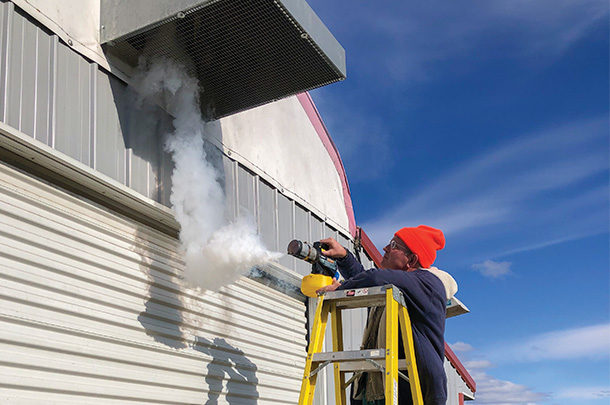How do you know if your calf barn is properly ventilated? You may see visual signs such as streaking or cobwebs on the purlins or be overwhelmed with the smell of ammonia and noticeable humidity as you enter the barn, letting you know your calf barn’s ventilation may be lacking.
To see what may be contributing to these visual and sensory cues, we need to look at the barn’s stocking density and primary mode of ventilation.
Are there too many calves in the barn?
Overstocking in the calf barn is unfortunately commonplace. This practice leads to a myriad of detrimental effects, one of which is poor air quality. When a barn’s stocking density is doubled, the ventilation rate must increase tenfold to compensate for the extra animals in the barn.
Having sufficient barn volume per calf starts with providing a minimum of 35 square feet of bedding space per calf for calves up to 400 pounds. As pen size increases, the bacteria concentration in the air is diluted. In a 2006 study, the industry average volume of barn per calf was 1,300 cubic feet with a range of 600 to 3,000 cubic feet. Bedding space and barn dimensions, such as high sidewalls, make it easier to achieve the average barn volume per calf.
Once the barn is appropriately stocked, we can assess whether the primary ventilation system is working properly. Until calf numbers are reduced, the ventilation system will remain insufficient.
How is the barn ventilated?
Most calf barns in the Midwest are naturally ventilated and often supplemented with positive-pressure tube ventilation (PPTV) systems. Natural ventilation occurs when air enters the barn through openings in the sidewall. This causes the old, stale air to rise as it warms due to thermal buoyancy, and it is drawn out of the barn through an open ridge as the wind passes over the roof, creating a suction effect. Some barns will have chimney fans instead of an open ridge to allow air to exit the building.
The following criteria must be met for natural ventilation to work properly:
1. The barn must be free of wind shadows. Wind shadows can be caused by nearby buildings, equipment, tree lines or seasonal obstructions like mature cornstalks. The recommended distance between obstructions is at least 100 feet.
2. Sidewalls should be open as much as possible in the summer. For barns that are 40 to 60 feet wide, the recommended sidewall height is 12 feet with a 12-to-18-inch concrete curb. Barns wider than 60 feet should have a sidewall height of 14 feet to allow more air into the barn to move across the wider distance. Split curtains are preferred to allow for greater control of air entering the barn throughout the year. In the winter, the minimum opening at the eaves on either side of the barn should be 1 inch for every 10 feet of building width to allow for the minimum winter ventilation rate of four air changes per hour (ACH).
3. The ridge should be open 2 inches for every 10 feet of building width to allow for sufficient outlet area. Chimney fans can be fitted to the ridge, but they too must have adequate outlet – a minimum of 0.5 square foot of outlet for every 100 square feet of barn floor.
4. The pitch of the roof should allow at least 1 unit of rise for every 4 units across to aid with the suction effect described above.
5. While barn orientation doesn’t directly impact natural ventilation, it is important to keep in mind. Barns should be oriented east to west in much of the U.S. to limit sun exposure inside calf pens and to capture prevailing winds.
Mechanically ventilated barns, where air enters in through an inlet on one end and exits via exhaust fans on the opposite end of the barn, should provide four air changes per hour (ACH) in the winter and 30 to 40 ACH in the summer. They should also have appropriately sized inlets that allow air to enter the barn at a rate of 500 to 800 feet per minute to allow for proper air mixing. In terms of air speeds, anything more than about 60 to 100 feet per minute at calf standing height (4 feet above the floor) in the winter is considered a draft. What we have yet to learn as an industry is how fast air needs to be to keep calves cool in the summer.
Is the PPTV system working?
Because the wind doesn’t always blow, many farms have installed PPTV systems to supplement natural ventilation to ensure the calf barn has a minimum year-round ventilation rate of four ACH. But how do you know the PPTV system is working properly? Here are a few things to look at:
- The fan should be installed at the end of the barn so it can only draw fresh air into the barn. If the fan is located inside the barn, it will recirculate contaminated air, thus defeating the purpose of the tube system.
- There should be no air restrictions to the fan. A visual inspection to check that nothing is blocking air flow (i.e., debris, louvers, thick mesh or an undersized hood) is recommended. If a hood is installed, it should be oversized (at least larger than the fan diameter) so air can pass through the hood at a rate of 500 feet per minute.
- The total fan capacity should provide enough air to ventilate the barn at four ACH. To calculate the fan capacity needed in cubic feet per minute, multiply the interior barn volume by four ACH and divide by 60.
- The tube should be fully inflated along the entire length and not flutter. If the tube is fluttering or you notice air coming out of the holes at various angles nearest the fan, then the tube diameter is likely not large enough. Increasing the tube diameter or adding stator blades can help reduce these issues, but we recommend contacting the fan manufacturer before adding stator blades to verify fan performance.
- Air jets from the tube should be directed to the calf microenvironment without creating a draft. The best way to assess air jet placement is to use an insect fogger with mineral oil (found at local hardware stores) to fog the tube. Be sure that the curtains and overhead doors are closed when fogging so the air jets are not influenced by outside wind forces. This is done best with two people – one person standing outside of the barn with the fogger near the fan and the other person inside the barn videoing how the air exits the tube. Once you have a visual of where the air jets are directed, you can use an anemometer (one that can detect air speeds of less than 100 feet per minute) to check that the calf isn’t feeling a draft (target air speed at 4 feet above the floor is 60 feet per minute with a range of 40 to 100 feet per minute). If there are excessive air speeds in the calf microenvironment, the holes may be too large. If the air isn’t getting to the calf pen or there is no air movement, then the holes may be too small or incorrectly located on the tube.
Assuming there is sufficient fan capacity, calves aren’t subject to a draft and the tube is inflated and stationary, you can feel confident that the PPTV system is performing as expected.
Whether the barn is naturally ventilated, supplemented with a PPTV system or mechanically ventilated, getting fresh air into and out of the barn while keeping calf numbers appropriate to avoid over-polluting the air are the fundamentals of a successful ventilation system.






